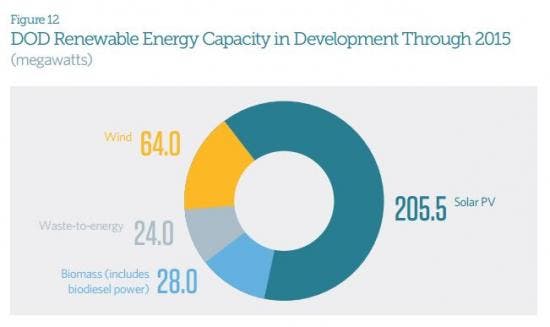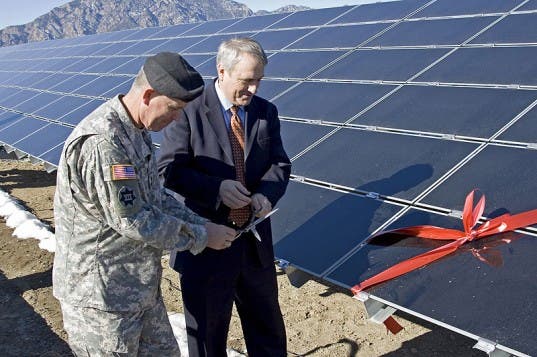In its “Energy Security and Sustainability Strategy” (ES2 Strategy) report, the US army outlines the steps it should take to increase resilience and adapt to an ever changing world. Energy makes the go world round, and for an army it’s literally a matter of life and death. Not surprisingly, the authors note given the current climate of affairs the “army will prioritize solutions that reduce multiple resources. The Army can use energy more efficiently by purchasing energy efficient products, modernizing buildings and utility systems, purchasing energy efficient vehicles, and using more renewable/alternative energy sources.” Basically, being dependent on a finite resource (oil) is a security vulnerability, which isn’t something new. Military strategists have been aware of this for a long time – maybe the most during WWII when many lives were claimed in battles over oil rigs in North Africa and the Middle East, and oil refineries were being bombed on the clock. What’s changed today is the feasibility of renewable energy sources. Drawing the line, in those situations were oil is a liability (and we can only expect these to become ever numerous in the future), it’ll be scrapped in favor of renewable energy systems, both for generating and storing energy.
Trust the force
The authors of the ES2 look to the future; a future where the US army integrates all its systems in a mutually reinforcing and holistic approach. They write:
“Our people are our strength… Our education and training will incorporate evolving knowledge, doctrine, and policy to guide Soldiers, Civilians, and Leaders to incorporate sustainability into planning and decision making. Organizational resilience and sustainability concepts will be integrated into Soldier and Civilian education programs at every level, from basic training to senior service colleges, as well as programs that focus on the holistic health and well-being of our people.”
The focus seems to be on managing critical resources and water. To achieve this, one part of the strategy is to diversify resources and disconnect them from another so a blow to one link doesn’t crumble the whole chain. Portable power (besides diesel generators; think micro-grid systems) seems like a huge concern in the Army’s energy mix. Previously, the Army announced it intends on powering all its military bases with net zero emissions. It is also experimenting with hydrogen powered tanks or solar-powered tents.
Then, there’s the sensitive matter of budget. Luckily (for them), the US heavily funnels money to the military, but the budget isn’t an endless pot of gold. Last year, the Department of Defense (DoD) spent $4 billion on energy expenses. In 2014, the Army reported its investing $7 billion to fulfill its congressionally mandated energy goal of generating one gigawatt, 25 percent of its energy requirements, from renewable sources by 2025 while improving installation energy security and sustainability.

Now, don’t get this wrong way. The Army is and will continue to be heavily dependent on oil, but the report’s emphasis on efficiency makes it clear than it wants to reduce oil usage and vulnerabilities to a minimum. Essentially, it looks like a sort of divestment away from oil. When the US Army or one of the world’s largest banks (HSBC) advises caution when depending on oil for military operations and financial investments, respectively, you know petrol is heading in one direction only: down.
Leave it to the goons

Meanwhile, it’s business as usual at Exxon – one of the world’s largest oil company. Amid historically low oil prices, the company netted $32.4 billion last year in net earnings. During a meeting last week, ExxonMobil and Chevron rejected a number of shareholder proposals that would address climate change, be it by setting goal for the reduction of greenhouse gas emissions or investing in renewable energy. Exxon CEO Rex Tillerson didn’t even mention the word climate change (is he also banned by Gov. Rick Scott?) during his speech and, moreover, ridiculed the thought of investing in renewables. ”We choose not to lose money on purpose,” Tillerson said, to loud applause.
Tillerson was quite critical of the global warming situation: the models aren’t good enough to predict global warming’s effects; the world isn’t going to be able to meet emissions targets; technology will enable us to engineer our way out of whatever crisis may or may not occur as a result of climate change. Note that he somewhat recognizes climate change is real, despite never mentioning “climate change” in a sentence. Very clever. So, if there will be great turmoil because of emissions (with Exxon as a huge contributor), what’s Tillerson back-up plan?
“Mankind has this enormous capacity to deal with adversity,” Tillerson said, acknowledging, “I know that is an unsatisfactory answer to a lot of people.”
“Humanity’s greatest challenges have always been solved by our prodigious son: technology. In the 1800s, the manure crisis threatened urban sanitation with a disaster. The Times of London estimated in 1894 that the situation was so dire that in 50 years every street in the city would be buried 9ft deep in horse droppings. The solution was the advent of the internal combustion engine, which eventually brought automobiles to replace horse buggies. Today, it’s not 9ft of manure that’s a threat, but 9ft of water. In the face of a much dire crisis, should we also this time wait for technology to save us?”



